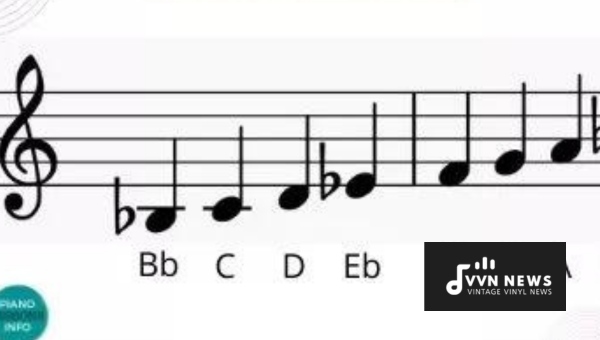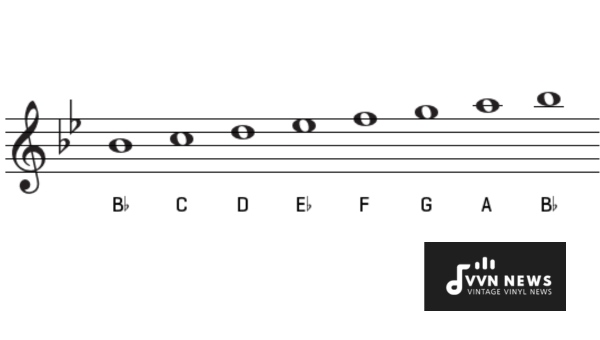If you’re a budding musician, you’ve likely grappled with questions about the essence of scales and their significance in the world of music.
One such musical wonder that is worth understanding is the B Flat Major scale.
With its uniquely pleasing, warm sound, it forms the basis for many renowned musical compositions.
Understanding scales and keys, like the B Flat Major scale, is crucial if you wish to enhance your musicianship.
Not only will this knowledge improve your technical skills, but it can also open doors to new creative avenues.
By the end of this post, you’ll be well on your way to mastering this beautiful musical element.
What Notes Form the B Flat Major scale?
The foundation of the B Flat Major scale lies in its note sequence. Start, as you might expect, with B flat (Bb).
Following this, we progress up the musical ladder to C, then to D. Next comes our friendly neighbor, E flat (Eb), ushering us to the midpoint of our journey.
A step up brings us to F, another jump leads us to G, and finally a leap to A.
The scale finishes by circling back home to our fresh start point – back to another triumphantly resounding B flat (Bb).
This is your melody roadmap, which leads you through the terrain of B Flat Major.
It’s a journey of eight notes that offers infinite possibilities for your musical imagination.
- Note 1: Bb
- Note 2: C
- Note 3: D
- Note 4: Eb
- Note 5: F
- Note 6: G
- Note 7: A
- Octave of the root note (Note 8): Bb
Always remember that practice makes perfect. Grab that instrument and start your melodious adventure through the realms of the B Flat Major scale!
Techniques for Mastering the B Flat Major Scale on Guitar and Piano

The magnificent B flat major scale invites an alluring blend of warmth and richness to any musical piece.
Let’s dive into some techniques that can help you effectively master this scale, whether your instrument of choice is a guitar or piano.
Techniques for Guitar
Mastering the B flat major scale on the guitar can feel overwhelming, initially. Here are a few steps to uncomplicate your journey:
- Start with Repetition: The B flat Major scale begins on the first fret of the A string (on B flat, indeed). However, it can be played in multiple positions across the fretboard. Practice playing up and down through these various permutations daily.
- Slow and Steady Wins the Race: Gradually increase your speed while maintaining the precision of finger placement.
- Incorporate Variations: Practice matching each note with its corresponding harmonic or work rhythmic exercises to keep things engaging.
Techniques for Piano
Executing scales on piano keys might appear intimidating at first glance but fear not, here is a simple approach:
- Memorize the Pattern: The pattern for a B flat Major Scale is: Bb – C – D – Eb – F – G – A – Bb. Play this pattern repeatedly to get comfortable.
- Understand Correct Finger Placement: For the right hand, start with the second finger on Bb followed by the thumb sliding under onto C, thus getting proper alignment for the rest of the notes in one fluid movement (Finger Transition 2–1–2–3–1–2–3–4). With left hand start with fourth finger on Bb leading into thumbs sliding onto D (Finger Transition 4-3-2-1-3-2-1).
Whether you’re an adept musician or just starting, consistent practice and gradual progression are key in your journey to mastering the B Flat Major scale.
Also Read: G Flat Minor Triad [Mastering Complex Guitar Chords]
What Are The Scale Degrees in the B Flat Major Scale
In musical theory, each note of a scale is assigned a degree that describes its position relative to the starting note, or root, of the scale.
This system of pitch organization offers a straightforward method for comparing different scales and modes.
When examining the B Flat Major scale, also known as the diatonic scale, consists of seven unique notes before repeating back on the octave.
- 1st (or tonic): B flat
- 2nd (or supertonic): C
- 3rd (or mediant): D
- 4th (or subdominant): E flat
- 5th (or dominant): F
- 6th (or submediant): G
- 7th (or leading tone): A
Each of these degrees has an essential role in creating harmony and tension within melodies.
For instance, the dominant note helps generate a sense of anticipation for resolution back to the tonic. On the other hand, the subdominant provides a reprieve from this tension.
What are the Key signatures of the B Flat Major scale?

The key signature of the B Flat Major scale primarily consists of two flats, namely B flat (B♭) and E flat (E♭).
The flats in this key signature make it distinctive to musicians, assisting them in identifying the scale swiftly and accurately.
The key signature is strategically placed on lines or spaces corresponding to the notes that need to be altered.
In written music, these flats are indicated at the beginning of each line, just after the clef sign.
Let’s break it down a little further:
- In the notation form, there’s a B♭ on the third line from the bottom of the treble clef staff. That gives us our hint that every B note in this piece will be played as a B flat unless stated otherwise.
- Furthermore, an E♭ is found in the fourth space from the bottom. Similarly, every E note should be played as an E flat.
Remembering these crucial elements will facilitate your navigation through scores with finesse and efficiency.
With its rich functionalities and singular form, the B Flat Major scale serves as a profound medium for exploring your musical imagination while refining your technical competence.
Representing the B Flat Major scale in Various Clefs
Music is a language shared by all, and like any language, it has its unique system of notation.
One of the most fundamental elements of music notation is the ‘clef.’ This symbol is used to denote which range of pitches will be used on the music staff.
Let’s delve into how the B Flat Major scale can be noted in four distinct clefs: Treble, Bass, Alto, and Tenor.
Treble clef
The treble clef (or G clef), commonly used for high-pitched instruments and voices, may appear complex at first but offers streamlined simplicity once familiarized with it.
While reading from a staff notated with a treble clef, the notes B flat major scale are written as follows: Bb-C-D-Eb-F-G-A-Bb again.
Bass Clef
On a staff marked with the bass clef (also known as F clef), primarily lower pitches are notated.
It’s commonly employed in music for lower-pitched instruments such as bassoon or cello.
For those using this clef, you’ll see your B flat major scale spelled out like so: Bb-C-D-Eb-F-G-A-Bb.
Alto Clef
For musicians playing instruments such as viola or alto trombone that occupy the mid-range pitches, you would use an alto clef (or C Clef).
In this case, the B flat major scale would be presented as follows: Bb-C-D-Eb-F-G-A-Bb.
Tenor Clef
Finally brings us to Tenor Cleff where you’ll find the following notation for our beloved B Flat Major scale: B flat – C – D – E flat – F – G – A – Back to B flat.
This understated clef is commonly used for instruments like the trombone or bassoon.
Knowing which clef suits your instrument and acclimating yourself to its respective representation will be integral in your journey of mastering the B Flat Major scale.
It’s like having a map to guide you in the vast landscape of musical composition.
With these tools in hand, trust that you’re well on your way to traversing this boundless terrain with ease.
Also Read: G Sharp Minor Chords [Guitarist’s Guide]
What is the Corresponding Minor Scale for B Flat Major scale?

Every major scale has a relative minor that shares the same notes, however, it starts from a different root note.
The relative minor scale corresponds to the sixth note, also known as the submediant of its relative major scale.
In the case of the B Flat Major scale, its notes are B flat – C – D – E flat – F – G – A. The sixth note in this progression is G. Therefore, G minor is the corresponding minor scale to B Flat Major.
Aurally, you’ll notice quite a distinction between these two scales.
While they share identical notes (with varied starting points), each emits a unique emotion and sound palette; B Flat Major often evokes feelings of warmth and fullness, whereas G minor tends to sound somber and melancholy.
Chart: Note Comparison
| B Flat Major | G Minor |
|---|---|
| B flat | G |
| C | A |
| D | B flat |
| E flat | C |
| F | D |
| G | E flat |
| A | F |
So next time you’re composing or improvising, recall this relationship between major and minor scales to add diversity to your music.
They can significantly alter the mood of a piece while maintaining a sense of cohesiveness due to their shared notes.
Primary Chords in the B Flat Major scale
The B Flat Major scale primarily comprises three essential chords, namely B-flat (I), E-flat(IV), and F(V). These chords are derived from the 1st, 4th, and 5th spots of the B Flat Major scale, respectively.
B-Flat
To visualize the B-flat chord (commonly notated as Bb), you’ll need to remember that it consists of three notes: Bb, D, and F.
E-Flat
The next chord you’ll encounter is the E-flat chord, denoted by Eb in most musical sheets. It contains three key pitches: Eb, G, and Bb.
F major
Lastly, we come across the major chord for F. Being composed of F, A, and C makes this triad quite harmonious.
With these elements under your belt, you will add immense texture to your music-making while enhancing your creativity.
Also Read: E Minor Pentatonic Scale [How To Use In Your Music Composition]
FAQs About The B Flat Major scale
Why is the B Flat Major scale important?
The B Flat Major scale is crucial as it forms the foundation for many pieces of music, and understanding it can significantly improve your technical abilities and creativity.
Does the key of B Flat Major have a particular emotion attached to it?
Yes, the B Flat Major key is often associated with warm, pleasing, and expressive emotional tones in music.
How many sharps or flats are in the B Flat Major scale?
The B Flat Major scale consists of two flats – B flat and E flat.
What minor scale corresponds to the B Flat Major scale?
The G minor scale is relative to, and shares the same key signature as, the B Flat Major scale.
What are some common chords in the key of B Flat Major?
Common chords within this key include B flat major (Bb), E flat major (Eb), and F major (F).
Conclusion
In conclusion, understanding the intricacies of the B Flat Major scale is key to mastering diverse musical compositions.
You’ll find that practicing regularly will aid in promptly recognizing and reproducing this scale, as well as enhancing your overall musical proficiency. This introduction is just a stepping stone.
Take this knowledge, practice consistently, and you’ll quickly incorporate it into your repertoire with ease!
Diving deeper into scales can truly open many doors to your music journey, welcoming an array of creative possibilities.








